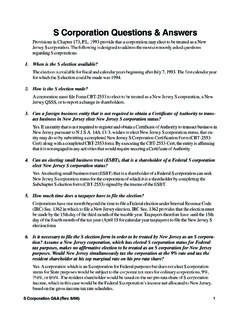Transcription of Section 338(h)(10) S Corporation Checklist - FAU
1 Section 338(h)(10) S Corporation Checklist (Rev. 9/05) PREFACE When the shareholders of an S Corporation decide to dispose of their interests in the Corporation in a taxable transaction, they have several alternative methods to effectuate the deal. From a tax perspective, a sale of all of the S Corporation s outstanding stock will result in the same total amount of gain or loss being recognized by the S Corporation s shareholders as a sale of all of the S Corporation s assets followed by a complete liquidation of the S Corporation .
2 However, with an asset sale, some of the gain may be taxed at ordinary income tax rates, while with a stock sale the gain would generally be all capital gain. In addition, with an asset sale, the built-in gain tax or passive investment income tax may There may also be state and local tax differences between a stock sale and an asset sale followed by a complete liquidation. From the buyer s perspective, a stock acquisition results in a cost basis in the stock acquired, but not in a step-up (or down) in the basis of the acquired Corporation s assets.
3 The tax attributes ( , net operating loss carryovers and earnings and profits) of the acquired Corporation remain with the Corporation . If the buyer acquires assets, the buyer s bases in the assets are stepped-up (or down) to reflect the purchase price paid by the buyer for such assets. The buyer does not succeed to the acquired Corporation s corporate tax attributes. In determining whether to structure the sale of an S Corporation as stock sale or as an asset sale followed by a complete liquidation of the Corporation , the additional cost of an asset sale from the seller s perspective ( , ordinary income taxed at a higher rate and built-in gain tax) is often compared to the benefit of the basis step-up received by the buyer.
4 Non-tax issues also come into play. Examples include the need to: determine who has responsibility for disclosed and undisclosed liabilities; decide what happens to unwanted assets; and address the situation of dissident shareholders . In addition, an actual sale of some kinds of assets may not be possible ( , certain licenses that are not transferable). State transfer taxes can also weigh against an asset sale. If the target is an S Corporation and a stock purchase is desired for non-tax reasons, but an asset purchase is desired for tax reasons, it is common for the target S Corporation s shareholders and the acquiring Corporation to agree to make an election under Section 338(h)(10).
5 Regulation Section (h)(10)-1(c) permits corporations making a qualified stock purchase (QSP) of a target S Corporation to make an election under Section 338(h)(10) jointly with the S Corporation shareholders . When this election is made, for tax purposes the sale of the stock by the selling shareholders is ignored. Instead, the S 1 However, for purposes of determining if the passive investment income tax applies, liquidating distributions are taken into account in determining if the Corporation has earnings and profits at the close of the tax year; thus, generally the passive investment income tax will not apply in the year of liquidation.
6 Corporation is deemed to sell its assets to the acquirer (in the form of new target) and to liquidate, generally under sections 331 and 336. Because the target s S status remains in effect throughout this deemed sales process, any gains or losses recognized on the deemed sale flow through to the shareholders (and adjust their stock bases for purposes of determining gain or loss on the deemed liquidation). The deemed asset sale may cause the built-in gain tax or the passive investment income tax to apply at the S Corporation level (but see footnote 1).
7 All shareholders of the target S Corporation (selling and non-selling) must consent to the Section 338(h)(10) election. It should be noted that an S Corporation could also be the acquiring Corporation . In that case, the acquiring Corporation could make a qualified subchapter S subsidiary (QSub) election with respect to the target, provided it acquires 100 percent of the target stock in the QSP and the target is a domestic Corporation and is not an ineligible Corporation as defined in Section 1361(b)(2).
8 The QSub election would be effective after the effective date of the Section 338(h)(10) deemed asset sale. See regulation sections (c)(1)(i) and (b)(4). This Section 338(h)(10) S Corporation Checklist is meant to make the experienced tax professional aware of certain federal income tax issues arising from a Section 338(h)(10) transaction involving an S Corporation target. YES NO COMMENTS Validity of S Corporation Status 1. Is the target Corporation an S Corporation at the time of the qualified stock purchase?
9 Note: Only certain target corporations can participate in a Section 338(h)(10) election. Members of a consolidated group, affiliated corporations, and S corporations can participate in a Section 338(h)(10) transaction. This Checklist focuses on S Corporation targets. In this regard, if stock of a purported S Corporation is purchased in a qualified stock purchase (QSP), it is critical to ascertain that the target Corporation has a valid S election in effect at the time of acquisition if a Section 338(h)(10) election is intended.
10 ____ ____ 2. Has the target S Corporation maintained its S status continuously since its most recent election? ____ ____ 3. Determine continuous S status by examining the following documents: Form 2553, Election by a Small Business Corporation . Make sure all shareholders at the time of the Corporation s current S election have signed the form. The consents of certain other shareholders may be required. See reg. Section (b)(2). Have appropriate consents been reviewed?









